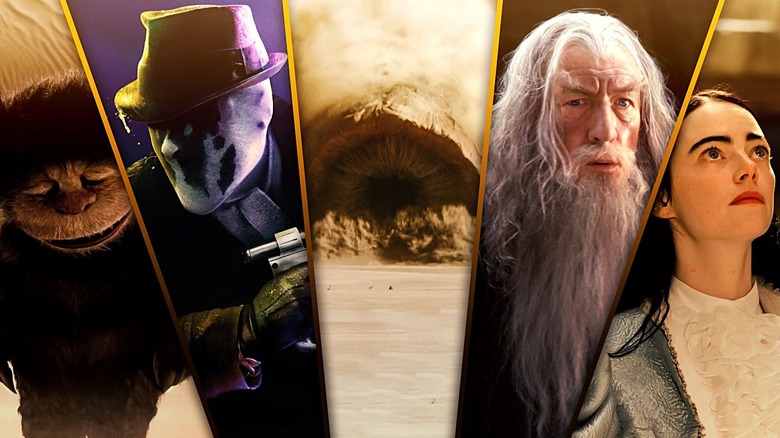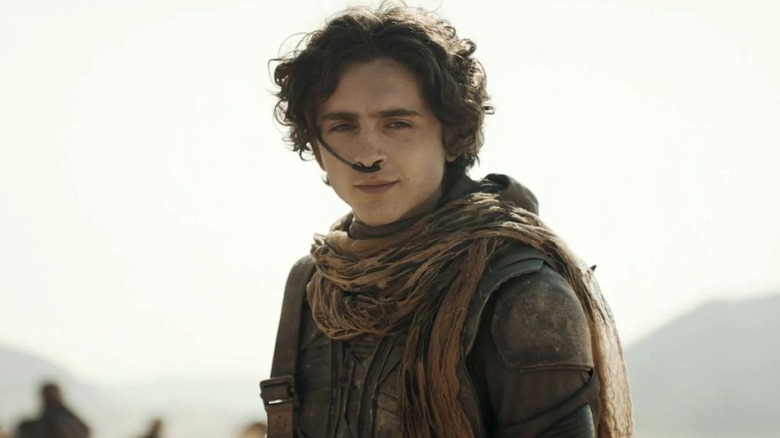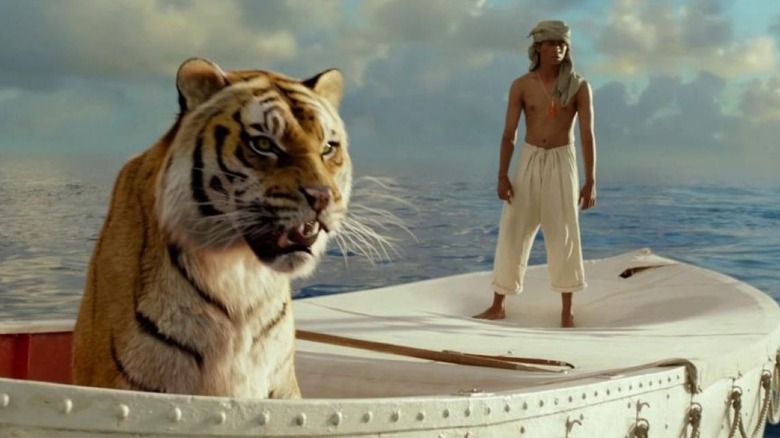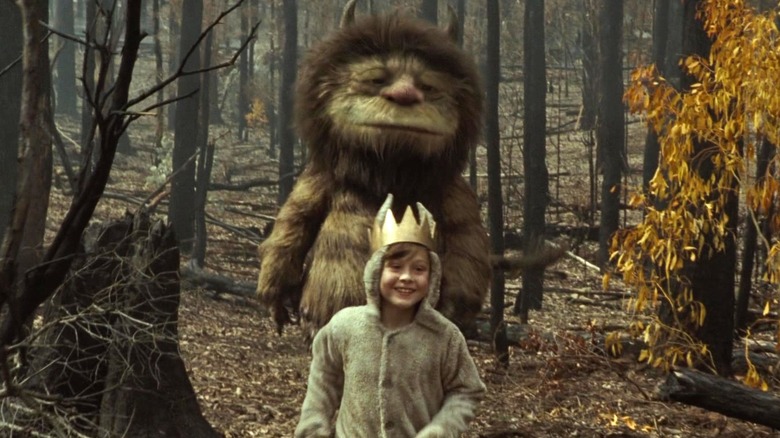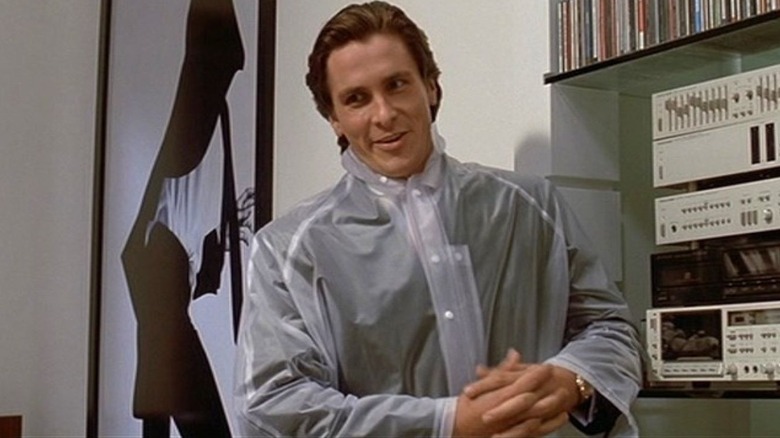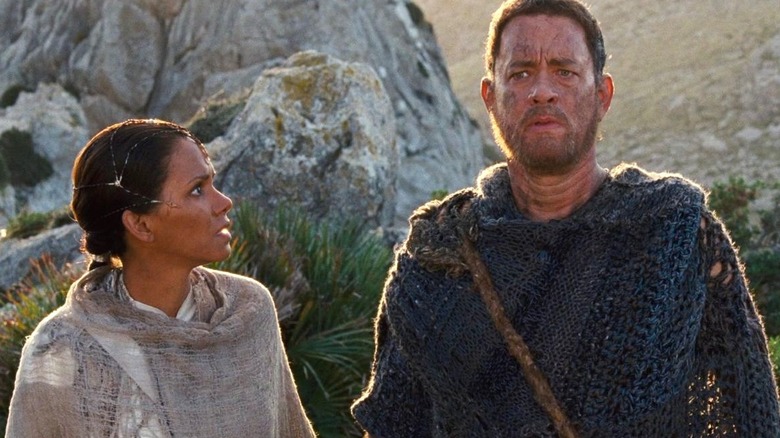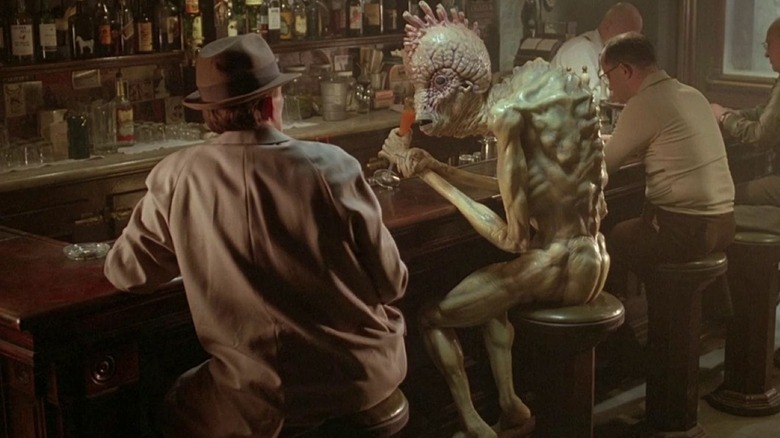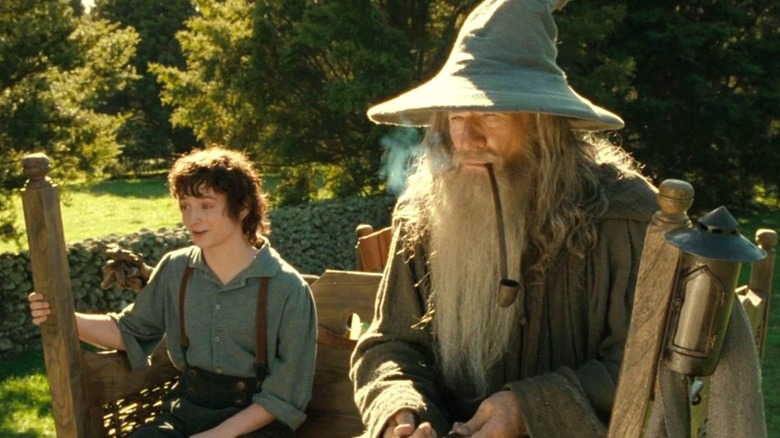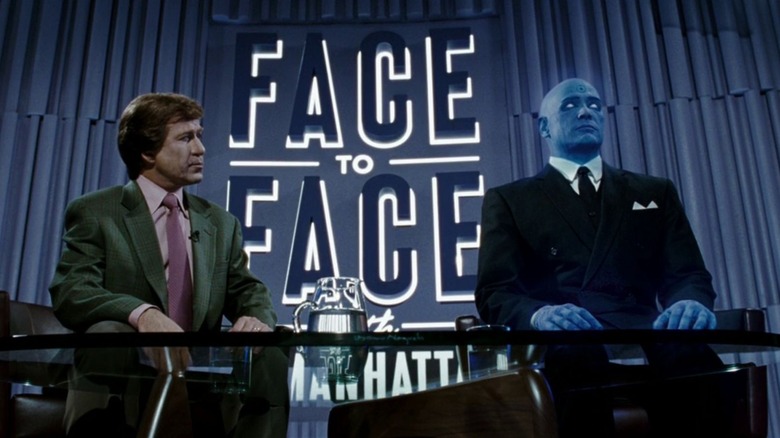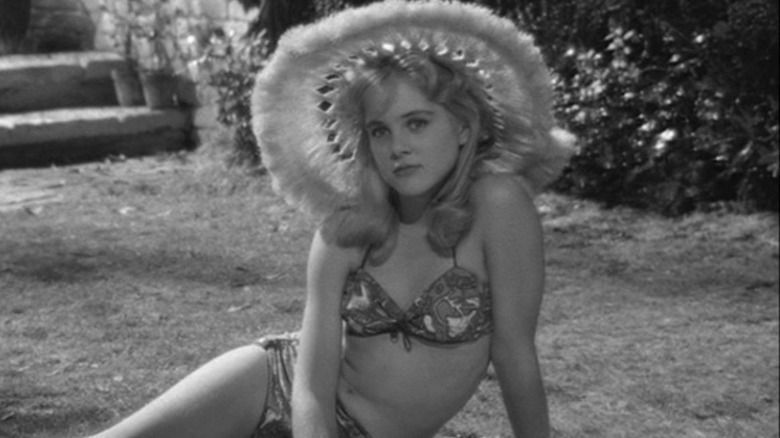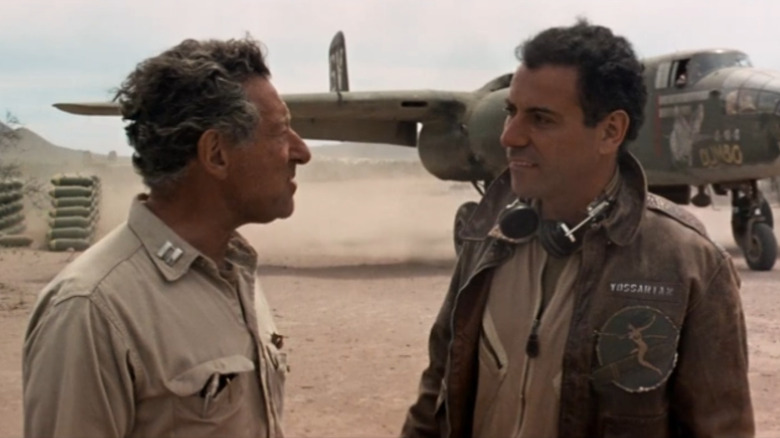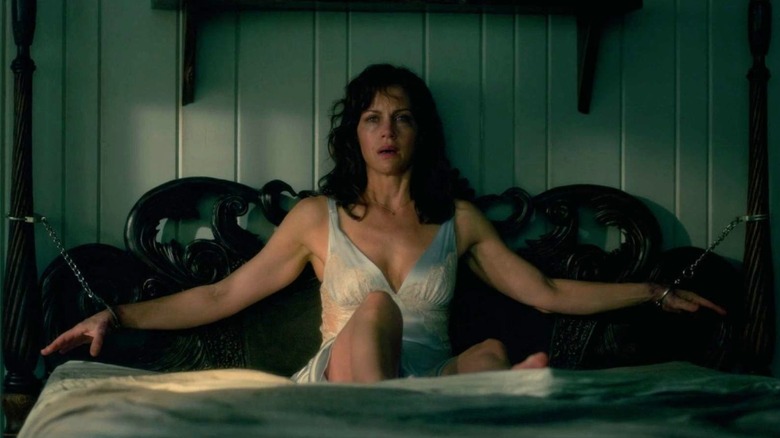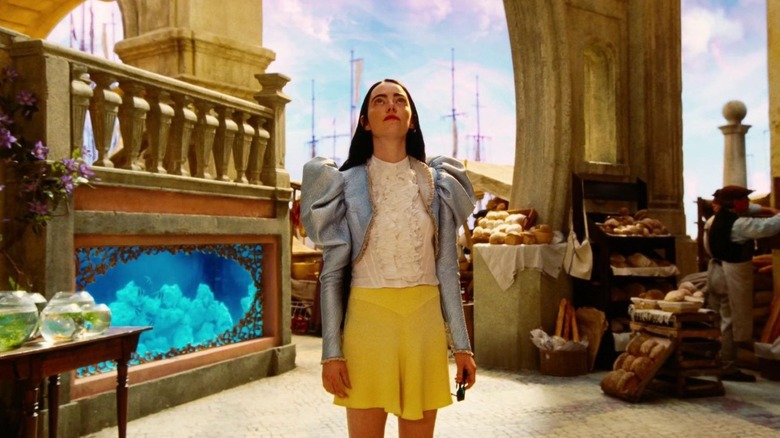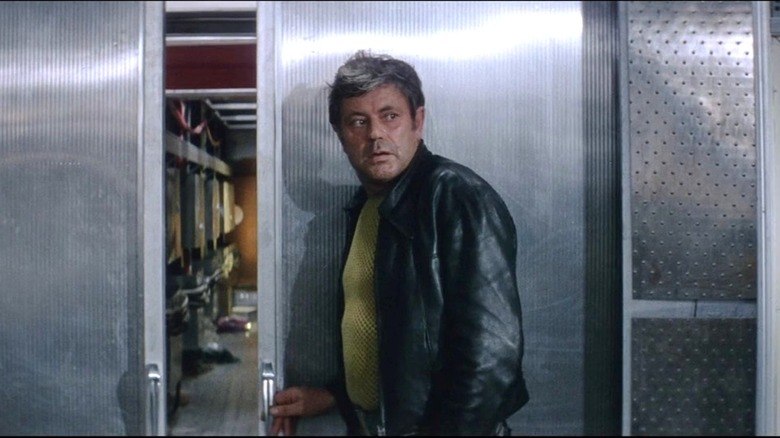The Best Movies Based On 'Unfilmable' Books
We may receive a commission on purchases made from links.
The book-to-screen adaptation is a tried and true formula that has led to some of the best movies of all time, like "Jurassic Park" and "The Wizard of Oz," which unknowingly paved the way for the success of "Wicked." However, not all adaptations receive the same praise. Movies like "Percy Jackson & the Olympians: The Lightning Thief" and the messy adaptation of "The Dark Tower" have been criticized for glossing over too many details. This proves that not all books, no matter how easy they might seem to adapt were meant for the big screen.
While some books are destined for a cinematic future, others have been deemed unfilmable. Perhaps a plot relies too heavily on mystical beings, sometimes tales are controversial and unsettling, which could turn away moviegoers. It's a label that some filmmakers walk away from, while others have taken on the challenge and proved everyone wrong. These are the filmmakers that used ingenuity to make the impossible possible and turned these unfilmable stories into big successes. So get your reading glasses, and let's take a look at the best movies based on "unfilmable" books.
Dune (and Dune: Part Two)
Until 2021's "Dune: Part One," the road to big screen success was filled with frustration and disappointment for fans of Frank Herbert's "Dune." The sci-fi book follows Paul Atreides, believed to be the messiah that will free the Freman who are the indigenous people of Arrakis. This land is the home of spice, a psychedelic drug that House Harkonnen is after. It's a sprawling story underlined with a deep religious history and political conflict that drives many decisions, and it was notoriously difficult to adapt. Alejandro Jodorowsky's 14-hour adaptation was scrapped in the 1970s. David Lynch's "Dune" was a box office bomb that killed any hope of a franchise. However, "Dune: Part One" and "Dune: Part Two" became Academy Award winners. So why do these films hit differently?
1984's "Dune" includes a lengthy on-screen narration followed by a slide-style presentation about three planets, and this slows down the entire pace. Denis Villenue tells the story successfully by strategizing every element. Chani (Zendaya) narrates the beginning of "Dune: Part One," as the story focuses on Arrakis amid the spice conflict. Sound is also critical, as the simple pounding of a thumper summons the infamous sandworms, giving the creature an entrance similar to "Jaws." It all makes for an incredible experience that immerses you on Arrakis.
Life of Pi
A tiger, one human character, and a literal ocean of perilous possibilities are reasons why "Life of Pi" was considered unfilmable. The 2001 book by Yann Martel follows a teenager named Pi Patel and a tiger named Richard Parker who travel in a lifeboat after Pi's family is killed when their freighter sinks into the sea, which once felt like a challenging task to film. But when technology finally made it possible, director Ang Lee used a digital tiger for scenes next to Pi (Suraj Sharma), and the ocean was created with a wave tank and digital tools. As for the project overall, Lee said, "But when I was first approached to direct it, it seemed like a crazy idea — and the book seduced me into it, because it was a puzzle to crack."
While "Life of Pi" is an adventure film, it's also about finding your inner-strength and leaning on lessons about life and religion. The religion side does require an explanation of how Pi became a student of many faiths. In order to translate this narrative visually, the main adventure is formatted as memories that an adult Pi (Irrfan Khan) shares with a writer (Rafe Spall), who is a version of Martel. It's a clever way to convey the first-person point of view that is crucial to the book. It's a lot of ground to cover, but "Life of Pi" pulled it off and became one of the highest-grossing non-franchise movies of all time.
Where the Wild Things Are
"Where the Wild Things Are" is visually striking, but making a quick bedtime story into a feature-length film seemed like a wild feat. The children's picture book by Maurice Sendak is about Max, a kid who loves to romp around the house, promoting his mother to send him to bed when he gets carried away. Instead of sleeping, Max travels to the land where the Wild Things are. This is all covered in Spike Jonze's adaptation, but what made this children's book into a big screen success was using an adult perspective to reflect on childhood.
The book is straightforward, but adults may notice that there is still room to grow. The book does not say much about Max's mom, and no details are shared about his ruckus. Jonze and his team fill in the blanks to create an emotionally captivating story about being misunderstood as a child. The movie gives Max (Max Records) a sister named Claire (Pepita Emmerichs) who ignores him, and his mom (Catherine Keener) is doing the best she can to support her family. Max believes that life is much happier with the Wild Things, but they also have struggles of their own. This expansion of the plot gives the story a much-needed extra layer that will make kids feel heard while adults remember their own growing pains.
American Psycho
A faithful book adaptation is what people hope for when hearing that a novel is becoming a film, but in the case of Brett Easton Ellis' "American Psycho," it's an approach that could have made this movie flop. The book is about Patrick Bateman, an investment banker by day and a serial killer by night. Ellis' text is a satire that examines Patrick's privileged life, but it also contains graphic violence and explicit sexual content that could turn audiences away. So, director Mary Harron put her own twist on the story, and it has become a cult classic.
Harron dials back the bloody scenes to make the film easier to watch, and that allows more room for her satirical take that offers some foreshadowing. This is evident when Patrick (Christian Bale) introduces himself by showing viewers his detailed morning routine, which includes a face mask that feels more like a foreshadowing tool as he peels it away to show the face hiding underneath. He narrates the whole routine, and his narration is key to making "American Psycho" stand out because it gives you a window into his thought process. It proves that every decision he makes (including who to murder next) is meant to increase his overall quality of life, and that gives viewers a look at the bigger picture of "American Psycho," which leads to an ambiguous ending.
Cloud Atlas
"Cloud Atlas" is about six people living several different lives over the course of five centuries. This story contemplates life and our existence, but it was deemed unfilmable because it's vast plot could lead to a confusing, overstuffed mess. However, the 2012 adaptation finds a way to give viewers an almost easy-to-follow road map.
The premise is established through a quick montage where characters are visited in different parts of history, putting you in the mindset for what's ahead. It then goes back to the 1800s and works up to 1973, which gives audiences a linear timeline to begin with. These scenes do feature different characters, but each scene ends on a poignant note that offers clues to how everything is connected.
Trying to connect several different characters is a challenge that was perfect for "The Matrix" power team of Lana & Lilly Wachowski, who wrote and directed the film with Tom Tykwer. Tykwyer told /Film that the team spent four years working on the script, and that hard work led to a film that strikingly showcases hope and the power of humanity.
Naked Lunch
"Naked Lunch" is one of the weirdest films from David Cronenberg, yet it's a spellbinding take on the unfilmable book. The 1959 novel by William S. Burroughs reads more like scattered essays than any sort of cohesive narrative, which is why an adaptation seemed impossible. These writings follow a man struggling with opioid addiction as he enters the Interzone and undergoes a journey about his own individuality.
The 1991 movie adaptation follows Bill Lee (Peter Weller), an exterminator who is addicted to bug poison. After taking a substance created by an insect, he accidentally kills his wife and ends up listening to the bugs. This film works because Cronenberg takes a step back and finds the pieces of the book that can build a clear narrative. This includes the death of Bill's wife, which is very different in the book.
As for the talking bugs and other bizarre creatures, Cronenberg had a vision that included the use of puppets and other practical effects, which create a roughness that compliments the film's dark tone. Weller's performance also helps the audience leave reality, because he acts like each bug is a living being as he hangs on their every word and does what he's told. It's a performance that helps make "Naked Lunch" the cult classic that it is.
The Lord of the Rings
"The Lord of the Rings" has a complex narrative that stands out from other fantasy novels. However, J.R.R. Tolkien's well thought-out approach to Frodo's adventures gave would-be adapters a challenge as intimidating as Mount Doom. Ralph Bakshi put his mark on the tale with an animated movie in 1978, and there was an animated TV special of "The Return of the King" in 1980. However, Peter Jackson's live-action version paid off thanks to how he interpreted important details.
One detail that is super important is how big everything is compared to the hobbits. They don't want to leave the Shire because the world is too big and too scary, which is why Frodo's journey is so harrowing. Scale can be tough to convey, but it was achieved by allowing the camera to angle up as Gandalf (Ian McKellen) talks to them and walks around Bilbo's (Martin Freeman) home.
It's important to note that Jackson's original vision for "Lord of the Rings" was quite different, and it consisted of two movies. That would have been a big mistake because it would have led to scrapped details and the rushing of big moments, like Frodo's (Elijah Wood) arrival in Mordor. The decision to make three films is a big reason why this adaptation is such a success. This offers just enough time to cover major moments while giving them room to breathe.
Watchmen
Zack Snyder's "Watchmen" movie was hailed by /Film as a marvelous cinematic achievement. The highly revered graphic novel series by Alan Moore was considered unfilmable because it's not your average superhero adventure. Instead, it's a commentary on humanity and history in an alternate 20th century where the attitude toward superheroes changes overtime. It's a superhero version of an historical drama which plays with several different genres, including noir, which is the opening tone for the comic series as it focuses on a vigilante named Rorschach (Jackie Earle Haley) discovering a murder plot aimed at all superheroes.
While his crucial entrance is included in the beginning of the film, it happens after a montage that helps viewers understand the dark tone of this alternate 1980s. That decision is crucial, because it allows newcomers to feel welcomed into the film instead of getting lost in a narrative that decades-long fans know so well. As for fan service, the script is highly committed to being a faithful adaptation and even offers little Easter eggs for readers, including the moment that a drop of Edward Blake's (Jeffrey Dean Morgan) blood strategically spills onto his smiley face pin, creating the iconic image seen on the series' front cover.
Lolita
Stanley Kubrick and James A. Harris' 1962 take on the controversial book chronicles a man's infatuation with a young girl who later becomes his step-daughter. Kubrick and Harris collaborated with author Vladimir Nabokov who had written a script, but Kubrick only used a fraction of Nabokov's "Lolita" screenplay. Kubrick is a master of book adaptations, and he knows how to use foreshadowing and metaphors to help expose a story's layers. That is evident in the beginning of "Lolita."
This is a story about obsession and desire, but Humbert's (James Mason) attempt to shoot Clare Quilty (Peter Sellers) offers another point. Quilty hides behind a portrait of a beautiful woman that Humbert shoots at in the hopes that he can hurt the man who hurt his step-daughter. His actions damage the painting, creating a moment that is a metaphor about the movie, which focuses on how two men stole a girl's childhood to satisfy their desires.
The 1997 adaptation takes a similar approach, as it starts with Jeremy Irons' version of Humbert driving with blood on his hands. While it's a foreshadowing of Humbert's murder attempt, the blood is a metaphor for the irreversible damage that he will cause, changing Lolita (Dominique Swain) forever. It makes for a dramatic opening that proves the point of the novel, which is how the actions of others can forever change someone's life.
Catch-22
The willingness to take on dangerous combat missions means you're crazy, but if you put in an official request to step aside, you'll be proven sane and your request will be revoked. It's the confusing rule that is at the center of Joseph Heller's novel "Catch-22." The rule is brought up as bombardier John Yossarian complains about the increased number of missions that one must fly in order to complete their service in World War II. It's a fascinating premise in this satire, but the book was deemed unfilmable due to this complicated rule and the fact that book's crucial third-person narrative couldn't be achieved, leaving out important context.
However, Mike Nichols' 1970 adaptation of "Catch-22" has been hailed as one of the best movies based on a banned book. It's entertaining because of how it emphasizes satire with character portrayals that rely on dry humor and absurdity. It's a tone that is set when Milo Minderbinder (Jon Voight) and Colonel Cathcart (Martin Balsam) completely ignore a nearby plane crash as they discuss a trading deal. It's a reminder that, while this is a war film, it should not be taken at face value. Meanwhile, Yossarian (Alan Arkin) is still trying to figure out how to survive, and it's a mission that reveals enemies in his own camp.
Gerald's Game
Many of Stephen King's books have been adapted into movies, but the idea of turning "Gerald's Game" into a feature length film seemed impossible due to it's psychological narrative and a limited amount of action. However, co-writers Mike Flanagan and Jeff Howard cracked the code.
Jessie Burlingame (Carla Gugino) is complicit in her husband's bondage games until a new inner-voice tells her that she doesn't have to put up with Gerald's (Bruce Greenwood) antics. She begs to be released from the handcuffs that are chaining her naked body to the bed, but he won't listen. The two struggle, and he dies of a heart attack. Jessie spends most of the film fighting different voices in her head as she focuses on survival. Those voices help drive the plot forward. It's a tricky element to achieve, but it's possible thanks to echo-like voice-overs.
Co-writer Jeff Howard told /Film that a few changes including putting Jessie in a slip, which is a change from the nudity in the novel. "Sometimes with books, especially with books that you love, there's just one or two things that you have to make concessions to actually make it something that will work," he said. Their creative choices make for a successful adaptation that will not disappoint King's fans.
Poor Things
"Poor Things" gained a reputation for being too whimsical and weird for film. The story about a doctor's revival of a dead woman includes pugs with duck heads and overly vibrant worlds. The novel is an immersive read that even includes a letter written by story narrator Archibald McCandless (known as Max McCandles in the movie), who is addressing an unknown doctor while asking them to read the following story from beginning to end, even if it's terrible. It's a first-person approach that helps Archibald set the stage for the unbelievable story that he's about about Bella Baxter while helping the reader feel like they're a part of this world. It's a lot for a film to achieve, but 2023's adaptation meets expectations.
The film is just as enthralling as the novel thanks to the stunning cinematography and production deisng. For example, as Godwin Baxter (Willem Dafoe) gives a medical presentation, the lens shrinks to a point where you feel like you're on the outside looking in, and that's how his colleagues feel, because they don't understand his work. As for color, the black and white overlay at the beginning of the film helps the audience understand Bella's (Emma Stone) perspective, which is one-dimensional because she hasn't explored the outside world. The screen switches to color as she experiences different things that make her world more vibrant. It should come as no surprise that /Film called "Poor Things" a beautiful and hilarious Frankenstein rift.
Solaris
Stanislaw Lem's "Solaris" takes sci-fi to a whole other plane where a planet is inhabited by an extraterrestrial intelligence that appears as a large body of water. It's a fitting form for this being that acts like a reflection to its visitors as it helps humans reveal their deepest obsessions while reminding them of the memories they want to forget. However, creating this major set piece and properly depicting the deep, philosophical portions of this novel is why it was deemed unfilmable.
The 1972 film confronts those philosophical questions at the beginning of the movie. Psychologist Kris Kelvin (Donatas Banionis) talks to pilot Anri Berton (Vladislav Dvorzhetskiy) who has already visited Solaris, but he still can't make sense of what happened to him. Anri and others question Kris' decision to travel to the station orbiting the planet.
However, Kris still makes the trip because he wants to help the station's crew recover after they were altered by the living water. Of course, water cannot talk, but it is clearly staring into the soul of each human inhabitant as it conjures hallucinations that are borrowed from the minds of each person that it talks to. It's a harrowing tale of survival that is abstract yet whole in this adaptation.
